Recent Posts
Preventing Heating Fires
2/8/2024 (Permalink)
 Heat your home safely as the cold outdoor temperatures persist.
Heat your home safely as the cold outdoor temperatures persist.
While modern heating systems are designed to be more efficient and have built-in safety features that minimize the risk of fires, it is crucial to note that heating fires can still occur due to various factors.
Is your property at risk? Let us help you get prepared with our checklist of preventative measures. But remember, if your property does undergo damage, we are open 24/7, 365 days a year to help you through it and to make it "Like it never even happened."
Overall, there has been a decline in heating fires over the years, however, they still pose a significant risk to homes and individuals. By remaining vigilant, staying informed about safety measures, and taking proactive steps to maintain heating systems, we can continue to reduce the occurrence of these devastating incidents.
Checklist for preventing heating fires
- Heat source proximity - Keep anything that can burn at least three feet from all heat sources including fireplaces, wood stoves, radiators, portable heaters, or candles.
- Electrical issues - Always plug space heaters directly into an outlet, and make sure its cord isn’t damaged or frayed.
- Improper usage - Never use an oven to heat your home.
- Maintenance - Maintain heating equipment and chimneys by having them cleaned and inspected each year by a professional.
- More information - Visit the U.S. Fire Administration Home Fires page to learn about how to prepare for and prevent home fires including tips for individuals with disabilities and older adults.
source: Ready.gov
Was this helpful? Leave us a review to let us know!
https://www.wereyouhappy.com/review2/SERVPRO-of-west-knoxville
SERVPRO Team Cuthbertson in the 2023 Oak Ridge Christmas Parade
12/19/2023 (Permalink)
 SERVPRO waives to the spectators from the decorated fleet vehicle at the 2023 Oak Ridge Christmas Parade.
SERVPRO waives to the spectators from the decorated fleet vehicle at the 2023 Oak Ridge Christmas Parade.
Our community is where our heart is and that’s why we like to invest our time and efforts in events like the Oak Ridge Christmas Parade. Each year, individuals, families, and businesses come together to celebrate the Christmas holiday with festive floats and decorated trucks and trailers. The streets are lined with spectators, including children who cheer, sing, and wave as the parade of brightly lit and decorated floats pass by. Holiday music can be heard all around, and Christmas Cheer is evident in the faces of all throughout the parade.
This year’s event, ?sponsored by the Oak Ridge Chamber of Commerce, was attended by hundreds of spectators and, according to Norm Nelson of the Oak Ridge Chamber, the 2023 parade boasted one of it’s largest float registrations in recent years.
Several news outlets were in attendance with live coverage of the event being broadcasted and recorded. One of these recordings can be viewed on the following Youtube link: https://www.youtube.com/watch?v=KWJxIHfUwoo
It is an honor to participate in family events like this one, and it is a testament to our community that it is such a huge success every year. The hard work and dedication of the people like Christine Michaels, Norm Nelson, and BreAnna Robinson of the Oak Ridge Chamber of Commerce are the driving force behind these great celebrations, which enrich and inspire this community that we are humbled and grateful to be a part of.
Fire Prevention for Homes and Businesses
12/7/2023 (Permalink)
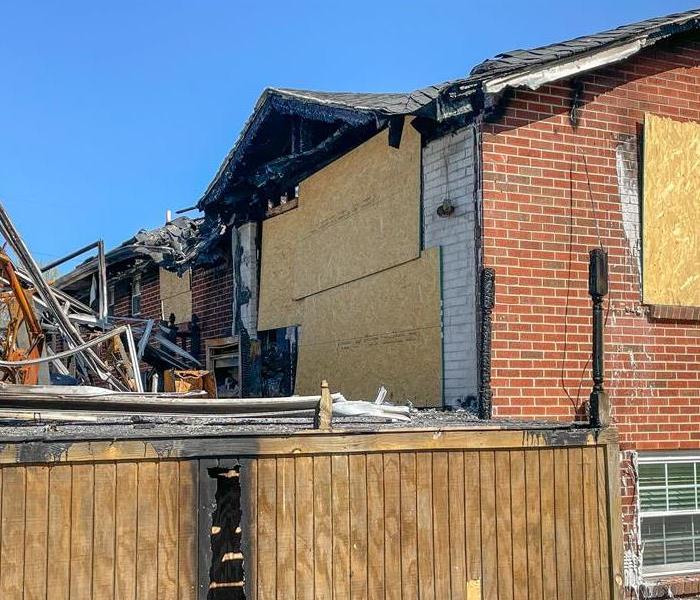 The effects of a fire can be devistating.
The effects of a fire can be devistating.
If you didn't know, it's National Fire Prevention Week. As much as we here at SERVPRO are here to help clean up after fires, our priority is always to help prevent them in the first place. So, we want to share some tips with you that will help keep you and your loved ones safe.
Fire is one of the most devastating disasters that can strike a home or business. It can cause extensive damage to property and possessions, and can even lead to loss of life. That's why it's important to take steps to prevent fires from happening in the first place.
Here are some fire prevention tips for homes and businesses:
Home fire prevention tips:
? Install smoke alarms on every level of your home, inside bedrooms and outside sleeping areas. Test your smoke alarms every month and change the batteries every year.
? Create and practice a fire escape plan with your family.
? Keep flammable materials away from heat sources.
? Be careful when cooking and using candles.
? Never smoke in bed.
? Have your electrical wiring and appliances inspected regularly by a qualified electrician.
Business fire prevention tips:
? Install smoke alarms and carbon monoxide detectors throughout your business. Test your alarms every month and change the batteries every year.
? Create and practice a fire escape plan with your employees.
? Keep flammable materials away from heat sources and electrical equipment.
? Be careful when using appliances and equipment.
? Have your electrical wiring and appliances inspected regularly by a qualified electrician.
How SERVPRO can help after a fire
If a fire does happen, it's important to call a qualified fire restoration company as soon as possible. SERVPRO is a leading provider of fire restoration services. We have over 2,000 franchises across the United States and Canada, so we're always nearby to help when disaster strikes.
Our team of highly trained and experienced professionals is equipped to handle all aspects of fire restoration, including:
? Emergency water removal
? Structural drying
? Smoke and odor removal
? Content cleaning and restoration
? Construction services We work with your insurance company to make the claims process as easy and stress-free as possible. We also offer 24/7 emergency service, so you can always count on us to be there for you when you need us most.
If you have experienced a fire, contact SERVPRO today. We're here to help you get your home or business back to normal as quickly as possible.
Additional fire prevention tips:
? Educate your family and employees about fire safety. Make sure everyone knows what to do in case of a fire.
? Have a fire extinguisher on every level of your home or business and know how to use it.
? Keep your fire extinguishers in good working order by inspecting them regularly and having them serviced by a professional.
? Consider installing a fire sprinkler system. Fire sprinkler systems can help to extinguish fires quickly and prevent them from spreading.
By following these fire prevention tips, you can help to protect your home or business from the devastating effects of fire.
Ensuring Turkey Fryer Safety for a Happy Thanksgiving
12/7/2023 (Permalink)
 Be sure to follow our safety instructions to aid in preventing a fire.
Be sure to follow our safety instructions to aid in preventing a fire.
Thanksgiving is a time for family, friends, and of course, a delicious turkey feast. While many families enjoy the tradition of deep-frying their turkeys, it is important to be aware of the potential safety hazards involved. SERVPRO, a leading provider of fire damage restoration services, is committed to helping families have a safe and enjoyable Thanksgiving by providing turkey fryer safety tips.
Turkey Fryer Safety Tips
- Choose the Right Fryer: Always use a turkey fryer specifically designed for outdoor use. Never use an indoor turkey fryer, as they pose a high risk of fire.
- Use a Safe Location: Place your turkey fryer at least 10 feet away from any structures or combustible materials. Never operate a turkey fryer in a garage, shed, or any enclosed area.
- Keep Away from Flammables: Keep any flammable materials, such as propane tanks, gasoline, or lighter fluid, away from your turkey fryer.
- Fill with Proper Oil: Use only the recommended type of oil for your turkey fryer. Never overfill the fryer, as this can increase the risk of overflowing.
- Thaw the Turkey Completely: A partially frozen turkey can cause the oil to splatter and ignite. Always thaw your turkey completely before frying.
- Lower the Turkey Slowly: Slowly lower the turkey into the hot oil to avoid splattering.
- Never Leave the Fryer Unattended: Never leave a turkey fryer unattended while it is in operation. Always have a fire extinguisher nearby in case of an emergency.
- Dispose of Oil Properly: Once the turkey is cooked, allow the oil to cool completely before disposing of it. Never pour hot oil down the drain.
SERVPRO's Commitment to Safety
SERVPRO is committed to helping families have a safe and enjoyable Thanksgiving by providing turkey fryer safety tips and fire damage restoration services in case of an emergency. With over 50 years of experience, SERVPRO has the expertise and resources to help you recover from a fire quickly and efficiently.
Enjoy a Safe and Happy Thanksgiving
By following these turkey fryer safety tips, you can help prevent fires and ensure a safe and happy Thanksgiving for you and your family. SERVPRO wishes you a safe and enjoyable Thanksgiving!
Office Fire Safety 101: Tips for Fire Prevention in the Workplace
12/12/2022 (Permalink)
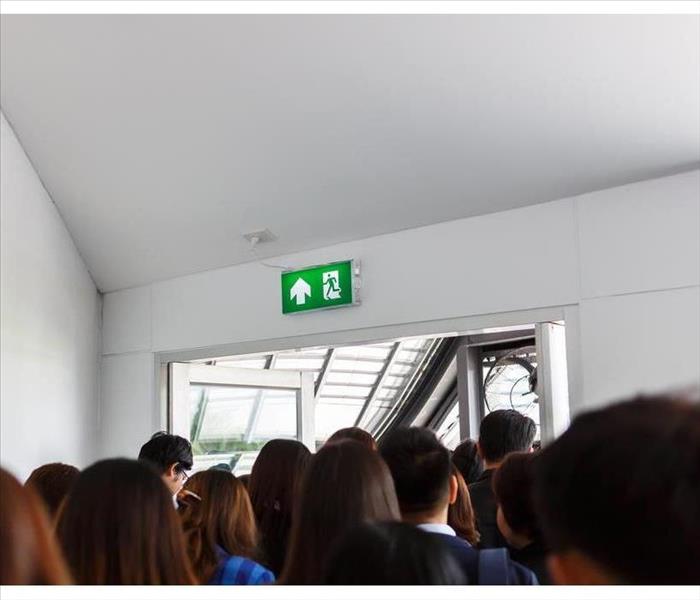 Make sure that everyone knows where the nearest exits are located.
Make sure that everyone knows where the nearest exits are located.
Fires are a risk at any workplace, but individual office environments have their own unique fire safety concerns. Whether you're an employee working in an office building or a business owner who's responsible for your employees' health and safety, it's important to be prepared for the possibility of a fire emergency. Here are some steps you can take to help ensure that your employees stay safe if there's ever a fire in your building:
Common Causes of Fires in the Office
Electrical Fires: Electrical fires are the most common cause of fire in offices. These fires can occur after power surges, electrical malfunctions, or when a circuit overloads.
Smoking: Cigarettes, cigars and pipes all contain burning tobacco products that can easily start a fire if not used with care.
Spills: Spills of flammable liquids like gasoline, solvents and other chemicals should be cleaned up immediately to avoid creating a layer that could ignite later in an unsupervised area.
Cooking: Cooking on hot plates or microwaves is prohibited in many office buildings due to the risk of starting a fire.
How to Get Ready for Workplace Fire Emergencies
Employee training
While it’s important to keep your employees safe, you don’t want them to be so worried about the possibility of a fire that they can't focus on their work. Proper training will ensure that everyone understands the signs of a fire and knows how to respond if one occurs.
Emergency plans
Once you've trained your staff in fire safety, put your plan into action with an emergency drill or two each year. Doing this will help you avoid any confusion during an actual emergency, as well as make sure that everyone knows where the nearest exits are located. If possible, include a mock evacuation scenario in these drills (like having someone play the part of someone who needs assistance evacuating). This way, you can test both how quickly people exit their workplace and whether there are any gaps in their knowledge.
Safety equipment
Fire extinguishers should always be installed throughout every workplace — they're cheap enough compared with other forms of hazard protection like sprinklers or CO detectors.
How to Implement Fire Prevention at Work
As an employee, you should be aware of the importance of fire prevention in the workplace. Your employer is legally required to take certain steps to keep your workplace safe. Fire alarms and extinguishers are two important things that can help keep your employees and property protected from fires.
If you're responsible for a facility, here's what you need to do:
- Install fire alarms that sound throughout the building when activated by smoke or heat
- Make sure they're working properly so they can alert people if there's ever a fire
- Get at least one ABC-rated fire extinguisher per floor or area (you'll want more in industrial areas)
- Train all employees on how to use it
- Keep exit routes always clear
The best way to keep your office safe from fires is to be fully prepared in case one happens. The tips we’ve outlined above can help you prevent fires, but there are also some other crucial steps you can take. First and foremost, make sure that everyone at your workplace knows what to do in case of emergency. Second, make sure that someone is always on hand with a fire extinguisher. Finally, don’t forget about things like regular maintenance checks and replacing worn-out equipment before anything goes wrong.
Sewage Damage Process
11/1/2022 (Permalink)
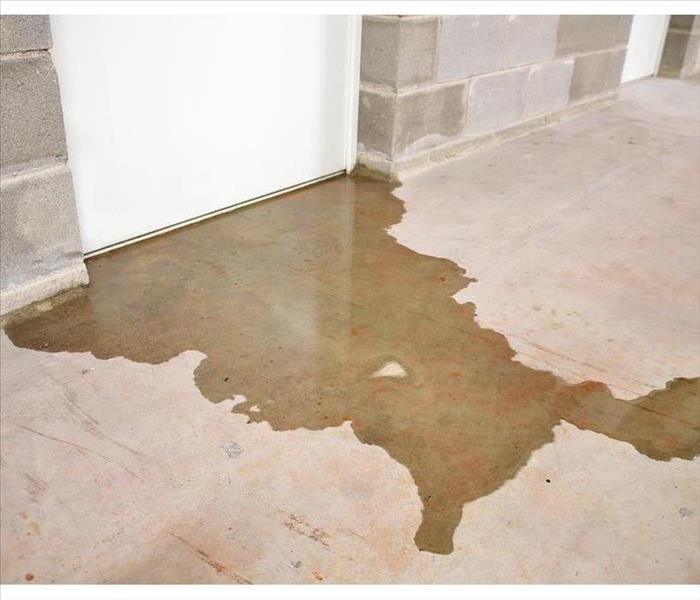 Sewage damage in a basement
Sewage damage in a basement
Process of Sewage Damage
Sewage damage is one of the most serious issues that you can encounter in your home. It can be difficult to clean up and repair, and there are times when identifying when it has occurred can be difficult. If you want to know whether you have sewage damage in your home, look for the following signs:
Potential Hazards
Once you decide to hire a professional, they will assess any potential environmental hazards, structural hazards, mold, and mildew hazards. If the property has been flooded with raw sewage or municipal wastewater, then it is likely that pathogens are present in the home’s air. These pathogens could lead to illness if not handled properly by a professional company that knows how to decontaminate such a property.
Sewage damage restoration companies have extensive experience in remediation of such issues and can assist you if you are unsure about hiring someone for this type of work
Pre-remediation Considerations
Pre-remediation considerations are important and can help you achieve the best results.
While it's tempting to do your own sewage damage cleanup and repair, there are a few things you should consider before taking on this project yourself. First, you'll want to make sure that you're hiring a professional contractor who has the proper equipment and skillset for the job. This way, they will be able to properly assess your situation and come up with an efficient solution for repairing any damage caused by sewage backup or flooding in your home or business property. Some contractors specialize in certain areas of work—for example, some focus solely on using biohazards material cleanup methods while others may specialize in removing odors after sewage backups have occurred. When choosing a professional contractor, it's important that they have all these qualities so they can best serve your needs as well as answer any questions that may arise during this process.
Special Remediation Situations
If the sewage damage is in your basement, you may have experienced a flood. If this is the case, you should take photos of the flooding and send them to your insurance company as soon as possible. Keep track of all costs associated with the cleanup process, including temporary housing and any lost work time.
If there’s a leak in your home that’s causing sewage backup into other areas or if there was an overflow at one of your neighbor’s houses due to clogged pipes (or whatever), these are both circumstances that require special handling. You can get help from an expert who knows how to handle these instances on behalf of your insurance company by contacting us today!
Sewage cleanup is best handled by professionals
If you have experienced a sewage backup, it is important to know the extent of the damage. Sewage cleanup is a specialized service and professional sewer cleaning companies have the equipment and expertise to handle any type of sewage damage.
In conclusion, sewage damage can be a serious issue that requires professional attention. If you're dealing with this problem and need some help, contact us today!
SERVPRO of West Knoxville Breaks Ground for New Facility
10/31/2022 (Permalink)
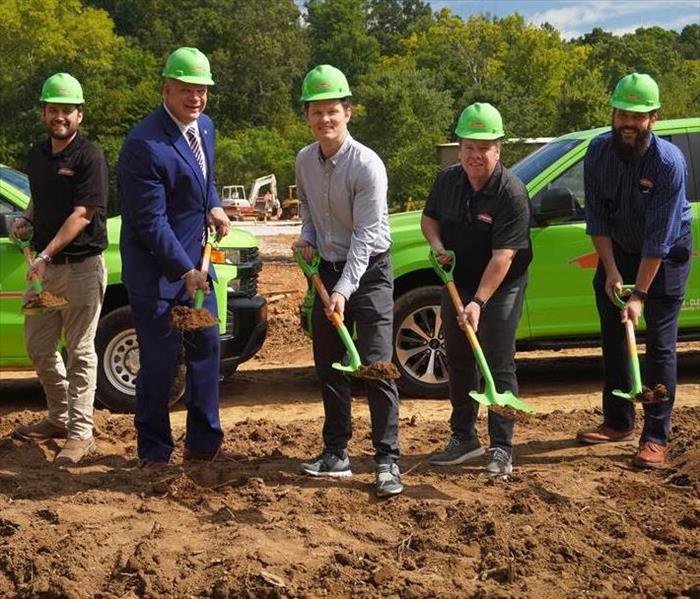 Jeff Cuthbertson, Jamie Shelley, Craig Hixson, Mayor Jacobs, and General Manager Ben Barker break ground on new SERVPRO location.
Jeff Cuthbertson, Jamie Shelley, Craig Hixson, Mayor Jacobs, and General Manager Ben Barker break ground on new SERVPRO location.
On September 8, 2022, Team Cuthbertson celebrated a milestone: SERVPRO of West Knoxville, North Knoxville, Northwest Knoxville, and Oak Ridge broke ground on our new offices and warehouse location in Knoxville, Tennessee.
The heartfelt outpouring from the local community at our groundbreaking ceremony was encouraging and uplifting as guests gathered to celebrate this exciting milestone for SERVPRO Team Cuthbertson. In attendance were Knoxville's local Chambers of Commerce, news organizations, and even Mayor Glenn Jacobs (formerly Kane from WWE wrestling!). With SERVPRO trucks and a construction site (complete with active bulldozers and excavators) as the backdrop, Jeff Cuthbertson, Jamie Shelley, Craig Hixson, Mayor Jacobs, and General Manager Ben Barker suited up in SERVPRO hardhats and dug their SERVPRO branded shovels into the dirt, making the ceremonial claim that a new 31,250 square foot building would soon stand there with the signature SERVPRO logo prominently displayed on the front.
The new facility will house offices, a training room for on-site educational courses and training, a client showroom, employee bunkroom, employee gym, and a warehouse that will include areas for full-service contents cleaning and restoration, as well as an ozone chamber.
The initial clearing of the site began on August 15, 2022, and construction continues to progress. The new building is expected to go vertical as early as the end of June or the beginning of July 2024. “We are humbled by the faith and trust that our clients and customers place in us to help them in their time of need, and we are excited for the new ways this facility will aid us in expanding and fortifying our robust capabilities”, said Jeff Cuthbertson, President and CEO of Cuthbertson Restoration, Inc. Cuthbertson, who opened his first SERVPRO franchise in Chattanooga, TN, in 2008, is now the owner of 15 franchise territories across Tennessee and Central Florida. The Cuthbertson team is among the top 5 largest SERVPRO franchises in the United States.
https://www.knoxvillechamber.com/SERVPRO-groundbreaking-ceremony/
How Do I Keep My Building Secure After a Fire?
10/10/2022 (Permalink)
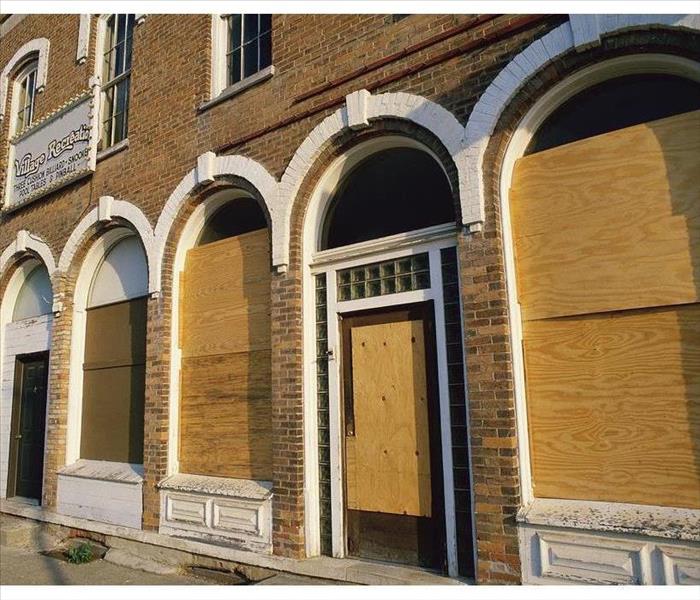 Board up services in a building.
Board up services in a building.
How Can I Maintain Building Security Following a Fire?
After a fire, the last thing you want to worry about is security. Unfortunately, someone could be trying to take advantage of your situation and steal from your business or home. Because of this threat, it's important that you board up any damaged doors and windows as soon as possible after a fire so that no one can get inside. But what kind of materials should you use for boarding up? How many days will it take? And most importantly: how much money will it cost? To help answer these questions, we've created some handy tips below.
Use metal sheeting to protect the inside of your building
In addition to using a tarp over exposed areas of the building, you can also use metal sheeting to protect the inside of your building. Metal sheeting is durable and can be used to cover windows, doors, and walls. It comes in a variety of sizes and shapes which allow you to customize its fit into any space.
Boarding up openings in the building after a fire keeps looters out.
To prevent looting, you can board up openings to keep people out of your building. If you have a fire, it's important to have an exit plan and know where your family members are going in case there is a fire.
Boarding up the building helps maintain security for you and your neighbors after a fire has happened. When boarding up openings in the building that were burned by flames or damaged by smoke, make sure they are covered with steel or aluminum sheets that are 2 inches thick or more. This ensures that no one can break into them easily while also providing protection against rainwater getting into them through cracks around windows as well as during high winds or heavy snowfall.
Check the weather forecast to make sure you use the right materials.
Fire can be a terrifying experience. If you ever must evacuate your home, it’s important to pay attention to the weather forecast so that you can decide what materials are best for the job and get them before they sell out.
Weather conditions can change quickly, so check the weather forecast every day before heading out to buy supplies. If it looks like rain is on its way or if there is a chance of high winds, consider using metal sheeting over wood as an alternative material. Metal sheets provide a more secure barrier against fire than untreated wood.
Contact us so we can create schedules and put boarding up as a priority as soon as possible
If you’re the owner of a business that’s been damaged by fire, don’t wait to get in touch with us. Call our office at (865) 690-9658 and we will be there as soon as we can.
We know that your building may be in disarray after a fire, but it also needs protection from looters, vagrants and other hazards until the restoration process is complete and you are back in business. We can board up the building so no one enters without permission and make sure that you are protected from weather elements until repairs can be made.
We understand that fire is a scary thing, but you don’t have to fear the aftermath. With our help, you can keep your building secure and safe from looters. We offer free consultations and will work with you every step of the way until everything is restored properly.
3 Reasons To Purchase Business Interruption Insurance
8/30/2022 (Permalink)
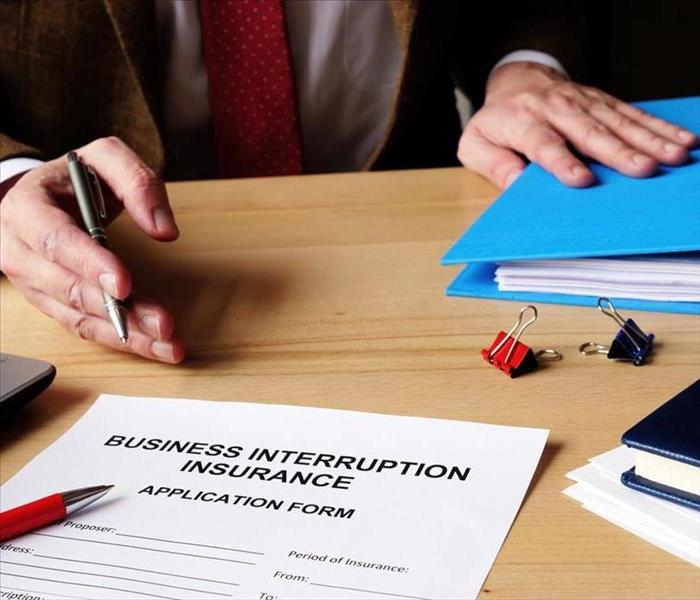 It is important to purchase business interruption insurance
It is important to purchase business interruption insurance
Three Good Reasons To Buy Business Interruption Coverage
If you own a business, you are probably aware of the importance of protecting your investment by purchasing property insurance. However, while property insurance can help you get your business running again, it doesn't pay for the income you are losing while your business can not operate. Interruption insurance can help keep your business from suffering financial distress while you wait for needed repairs. These are three of the reasons to purchase this coverage.
1. Replaces Lost Income
Depending on how severe your damage is, it could take weeks or even months to fully restore your business to preloss condition. During this business interruption, you may not be able to operate at all, or may only be able to operate at reduced capacity. This coverage replaces income lost due to a covered cause of loss based on your past financial records.
2. Helps You Pay the Bills
Even if your business is shut down, you probably still have bills. You will need to pay the mortgage or rent on your facility, any utilities that still need to be connected when your business isn't operating, make payments on any business loans, pay your taxes and other business expenses that may not stop just because you are not making money. Interruption insurance helps you cover those bills while you are not operating.
3. Provides Money To Pay Employees
Your employees probably can't afford to go without a paycheck while your business is shut down for fire restoration. This insurance helps you keep employees on the payroll so that you don't need to hire new employees in Ebenezer, TN when you are ready to reopen.
When a fire or other disaster occurs, it is important to protect not only your property but your income. Without the protection afforded by interruption insurance, you may find it difficult to keep your business from closing permanently.
The Specialized Equipment Needed for Mold Remediation
8/23/2022 (Permalink)
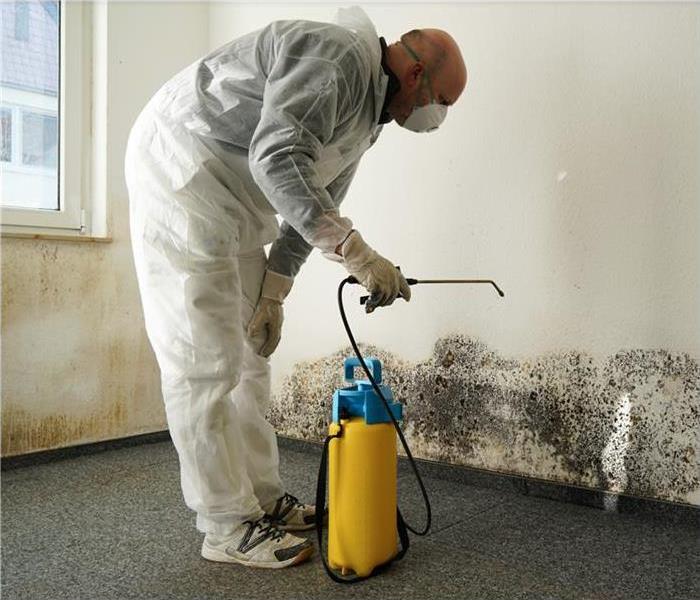 Face masks and many other types of equipment are needed to do the job safely.
Face masks and many other types of equipment are needed to do the job safely.
While it might be tempting to consider cleaning a mold outbreak in your home by yourself, in most cases this is a job for trained professionals. If the outbreak is minor, you might be able to clean the area and hope for the best. Quite often, though, the mold will return in a short time. For most jobs, highly-trained technicians and specialized methods are needed to defeat mold. The use of PPE such as face masks is often necessary. Breathing in microscopic mold spores is never a good practice. A local mold remediation team in Blue Grass, TN, will seek to remove mold in the safest way possible for its employees and the people in your home.The use of Protective Equipment
In addition to properly fitting face masks, professionals will use a number of measures to avoid inhaling particles of mold. Best practices often call for workers to wear the following PPE:
- A face covering such as a N-95 respirator
- Long gloves that extend to the forearm
- Goggles that are sealed against leakage
The goal is to prevent mold spores from entering through the mouth or the eyes. The gloves and other equipment also helps make sure any cleaning agents do not touch the skin. Mold technicians know the best equipment to wear as well as how to wear the equipment.
The Restoration of Mold Damage
Mold in your home can create an eyesore and impair indoor air quality. It can also break down the materials it feeds on, including drywall, furniture and carpeting. A mold remediation crew can do several things: locate the mold, remove the cause of mold (usually excess moisture) and repair the damage caused by mold. This might include rebuilding walls, replacing carpeting and repainting areas of the home.
Mold restoration is a complicated process. Face masks and many other types of equipment are needed to do the job safely.





 24/7 Emergency Service
24/7 Emergency Service








